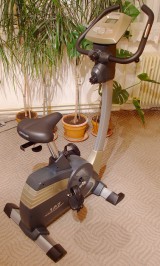The month of October makes most people think of pumpkin spice lattes, vibrant leaves, and Halloween costumes. But here at Premier Orthopaedics, we have something else we keep an eye out for, too, because it's also the time of year known as National Spine Health...
LATEST BLOGS
September is National Vascular Disease Awareness Month
As September starts, it's National Vascular Disease Awareness Month. This is a great time to learn about the health of our veins and arteries. Vascular diseases include problems like deep vein thrombosis and peripheral arterial disease. Read on to learn how to keep...
Causes & Treatment Options for Sciatica
Pain that starts in the lower back and radiates down the back of the leg is what is commonly referred to as sciatica. The pain follows the path of the sciatic nerve down the leg which means that typically, only one side of the body is affected. The sensation that...
Safe Ways to Maintain Fitness after an Injury

After suffering an injury, your physical activity may be limited. This can be frustrating, especially if you’re used to daily exercise or if you’re conditioning for a specific sport or a marathon. It’s very important to immobilize your injury or risk injuring it again.
There are ways to isolate body parts to stay in shape while allowing the affected area to heal. While one part of the body is immobilized, you can still exercise the rest of the body. For example, if one leg is injured, simply use the other leg.
Avoiding any sort of physical activity or exercise while you’re injured is a good way to ruin all of the hard work you’ve put into your workouts and the progress that you’ve made. Follow the tips below to stay in shape when dealing with an injury.
Swimming
Swimming is a great alternative to running or other aerobic activities. Because there is little to no impact on your bones, you can get all the benefits of cardiovascular fitness without re-injuring yourself.
If your leg is injured, you can use a pull buoy, or leg float, to place between your thighs or ankles to keep you from kicking with that leg.
Water running is another great method that can increase heart rate while decreasing the impact of running on the ground. Run as you would outside of the water and drive your knees like you’re sprinting to keep your heart rate up. Perform short intervals of 30 seconds to a few minutes, then slow to a walk or swim, repeating for 10-20 minutes.
Patients with shoulder injuries should not use the affected arm to swim. Use the opposite arm or practice water running only.
Stationary Bike
Biking on a stationary bike can be beneficial to patients who suffer from many injuries, with the exception of ankle issues. Biking, or spinning, can be a great alternative to running because your heart rate increases and you build strength.
One great thing about a stationary bike is that resistance can be controlled. Increasing the resistance is a great way to build your strength, but be sure that your pedaling stays at a high speed.
You may want to try biking at intervals to keep this stationary activity interesting. Start out by warming up for 10 minutes at a comfortable speed with a moderate resistance level. After your warm up, alternate fast pedaling with a high resistance for 30 seconds to one minute with slower pedaling and less resistance, repeating for about 20 minutes. Remember to perform a 10-minute cool down with little resistance and slower pedaling to allow your muscles to recover.
If you’re faced with a painful injury that requires several weeks or months to heal, don’t get discouraged. Try to go about your workout as normal, tweaking it in certain areas and keeping your injury in mind.
Be sure to discuss your plan to continue exercising during your injury with your doctor because he or she may have some suggestions for you.
For more information about sports injuries, treatment, and recovery, click here to download our e-book The Athlete’s Guide to Reaching Peak Sports Performance and Preventing Injury. This educational guide will help you improve your performance, prevent injuries and keep your body in great shape.



